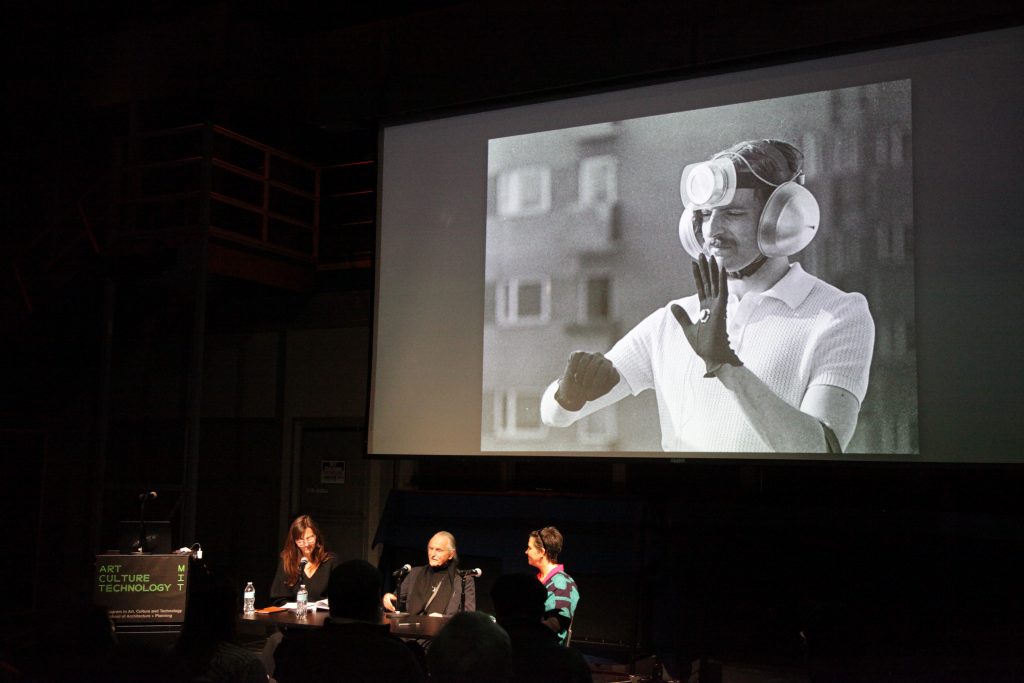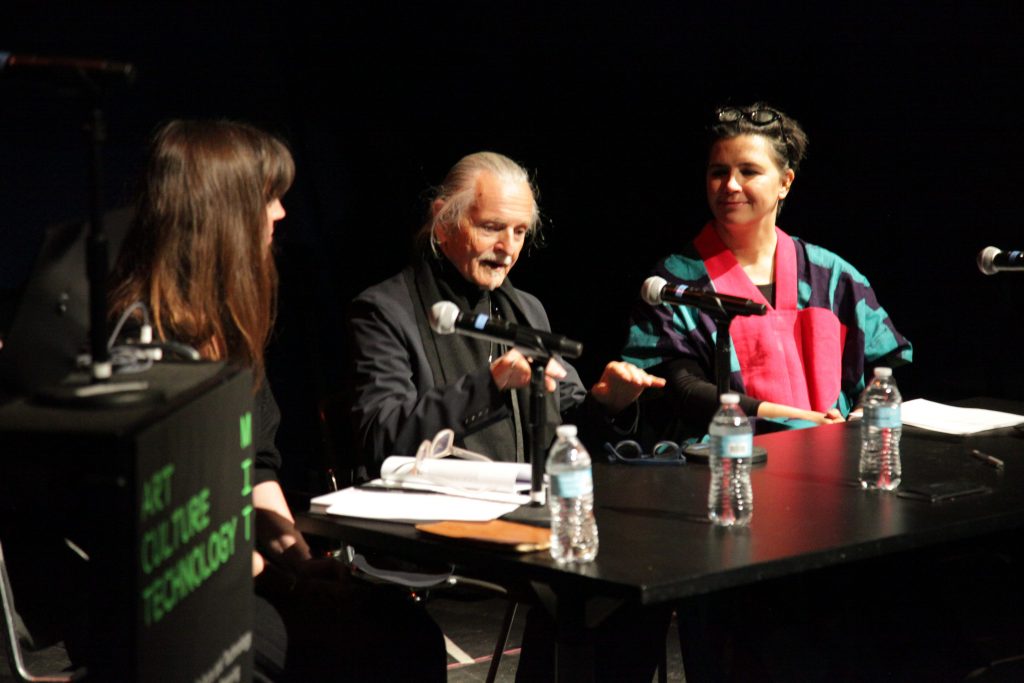Interrogative Design: Symposium and Book Launch in response to art legacy of Krzysztof Wodiczko
Thursday December 5 – Friday December 6, 2024
MIT Art Culture and Technology
ACT Cube
MIT E15-00, 20 Ames Street, Cambridge, MA 02139
Register here
Thursday, December 5 at 6:00 PM
Book Launch of Interrogative Design with the MIT Press and the MIT Press Bookstore
Introductory remarks by Dean Hashim Sarkis of the MIT School of Architecture + Planning
Book presentation by the editor, Ian Wojtowicz (SMACT ’12)
A keynote conversation with Krzysztof Wodiczko, an audience Q+A, and a book signing
Friday, December 6 at 12:30 PM
Symposium, Panel 1: Body Scale
Focusing on themes such as Cultural Prosthetics, Ethics of Technology, Realism, and Interrogation.
Featuring Kelly Dobson, Sohin Hwang, Zenovia Toloudi, and Marisa Morán Jahn (SMVisS ’07), along with Sara Hendren and Warren Sack serving as moderators.
Friday, December 6 at 2:30 PM
Symposium, Panel 2: Civic Scale
Focusing on themes such as Trauma, Memory, Monuments, Public Space, and Participation.
Featuring Ian Wojtowicz (SMACT ’12), Doris Sommer, Pelin Tan, Gediminas Urbonas, and Malkit Shoshan, along with Dora Apel and Mark Jarzombek serving as moderators.

The Interrogative Design Symposium is organized as a celebration of the artistic and intellectual legacy of Krzysztof Wodiczko, Arts Culture and Technology (ATC) Professor Emeritus, with the launch of the book Interrogative Design, edited by Ian Wojtowicz (SMACT ’12) and published by the MIT Press. The Symposium examines the role of art and design in activating the public sphere and enriching public discourse through the production of critical questions.
Interrogative Design is a timely collection that shows how design can animate public space and catalyze democratic processes through vital discussion and public engagement.
“Design thinking” emphasizes the production of solutions after a period of research. By contrast, interrogative design focuses on activating the public sphere and enriching public discourse through the production of questions. A notable contribution to the fields of critical design and media art, interrogative design traces its development to Krzysztof Wodiczko and his 1990s public art projects, documented in the book Critical Vehicles.
In Interrogative Design, Ian Wojtowicz showcases this lineage with new writing from Wodiczko and a host of contributions from diverse and influential practitioners, including Rosalyn Deutsche and Antoni Muntadas. This book highlights the dynamism of interrogative design as it is practiced today.
Never has the need for work that provokes thoughtful discourse been more necessary, and this volume catalogs both the need and potential viable techniques. A consolidated collection on the legacy and the vital currency of interrogative design, this volume will delight practitioners with new material and serve students as a practical handbook.



List of book contributors: Dora Apel, Dan Borelli, Kelly Dobson, Harrell Fletcher, Pete Ho Ching Fung, Dana Gordon, Sara Hendren, Garnet Hertz, Sohin Hwang, Ekene Ijeoma, Marisa Morán Jahn, Mark Jarzombek, Jaekyung Jung, Sung Ho Kim, Jean-Baptiste Labrune, Pia Lindman, Ani Liu, Andrew Todd Marcus, Matthew Mazzotta, Alex Milton, Max Mollon, Mariana Morais, Antoni Muntadas, Gauri Nagpal, Maria Niro, Ginger Nolan, Robert Ochshorn, Adam Ostolski, Sofia Ponte, Gustavo Romeiro, Natalia Romik, Warren Sack, Kirk Savage, Nitin Sawhney, Sanjit Sethi, Samein Shamsher, James Shen, Carl Solander, Richard Streitmatter-Tran, Orkan Telhan, Bruce M. Tharp, Stephanie M. Tharp, Zenovia Toloudi, Marek Wasilewski, Lani Watson, Sampson Wong, and Ben Wood.




Photos by Gearoid Dolan
About Krzysztof Wodiczko
Krzysztof Wodiczko (born 1943, Warsaw, Poland) has been creating site-specific slide and video projections both within galleries and using architectural facades and monuments as backdrops for nearly thirty years. These politically-charged works of art, which have been shown in over a dozen countries around the world, speak to issues of human rights, democracy, violence, alienation, and inhumanity, and using sound and motion often include testimonies of the people whose plights they address. Complementing these projections are Wodiczko’s nomadic instruments, designed to empower marginalized members of society such as immigrants, the homeless, these who lost their closest to street violence and war, women, and children-survivors of domestic abuse, the war veterans and others.
Krzysztof Wodiczko emigrated twice, from Poland to Canada and then from Canada to the United States. He now shares his time between New York and Cambridge, Massachusetts, where he is a professor a head of Interrogative Design Group, and a director of the Center for Advanced Visual Studies and the at the Massachusetts Institute of Technology.
Since 1980, has created over 70 Public Projections of still and video images that critically animate historic monuments and civic edifices. Public Projections with still images include: The Grand Army Plaza Memorial Arch, Brooklyn, NY (1983); The South African Embassy, London (1985); The Hirshhorn Museum, Washington D.C. (1988); The Whitney Museum of American Art, New York (1989),The Lenin Monument, Berlin (1990) and Arco de la Victoria, Madrid (1991). Public Projections involving sound and motion began with City Hall Tower, Krakow (1996) and later engaged the following monumental city symbolic structers:
Bunker Hill Monument, Boston (1998); A-Bomb Dome, Hiroshima (1999); El Centro Cultural, Tijuana, Mexico (2001); facade of the National Gallery in Warsaw (2005) and the Kustmuseum Basel, Switzerald (2006). The Hiroshima Projection, was organized after Krzysztof Wodiczko was awarded the Hiroshima Art Prize.
Throughout his career, Mr. Wodiczko has also developed a series of tools and devices for urban interventions, such as Homeless Vehicle (1988-89), Poliscar (1991), as well as portable and wearable communication instrumentations such as Alien Staff (1992), Porte-Parole (1994), AEgis (2000) and Dis-Armor (1999-present). Dis-Armor, which was first developed for the City of Hiroshima, than was on view in the Triennial exhibition at the International Center of Photography and more recently in the exhibition the Interventionists at MASS MoCA.
Mr. Wodiczko’s work has been exhibited in numerous international festival and exhibitions including: Paris Biennale (twice), Biennale of Sao Paulo( twice), The Sydney Biennale, Documenta, Germany (twice); The Kwang-ju Biennale, South Korea; The Venice Biennale (twice); The Biennale in Lyon, France, The Helsinki Biennale, Whitney Biennial, Kyoto Biennale, the Yokohama Triennale and the International Center for Photography Triennial in New York. www.krzysztofwodiczko.com
About ACT
The Art, Culture, and Technology program (ACT) at MIT is an academic program and center of critical art practice, intelligence and discourse within the School of Architecture and Planning. Through an integrated approach to pedagogy, hosting, public event programming, exhibitions, and publications, ACT builds a community of artist-thinkers around the exploration of art’s complex conjunctions with culture and technology. It is not an art school in the traditional sense. The program’s mission is to promote leadership in critical artistic practice and deployment, developing art as a vital means of experimenting with new registers of knowledge and new modes of valuation and expression; and to continually question what artistic research and learning environment can be and do.
Born out of the 2009 merger between MIT’s influential Center for Advanced Visual Studies (CAVS, founded in 1967 by György Kepes) and Visual Arts Program (VAP, founded in 1989), ACT shares a rich heritage of work that expands the notion of visual studies and pushes the capacity of art to enlist science and technology in cultural production, critique, and dissemination at the civic scale.






